Handmade soaps stay harder longer due to their fatty acid composition, particularly when rich in saturated fats like lauric, myristic, palmitic, and stearic acids. You'll find coconut oil, tallow, and palm oil create firmer bars that resist dissolving. Proper curing (4-6 weeks) allows excess moisture to evaporate, while balanced pH levels (7-10) enhance structural integrity. Environmental factors like humidity and water exposure also impact longevity. Discover how simple formula adjustments can dramatically extend your soap's lifespan.
The Science Behind Soap Hardness Measurement
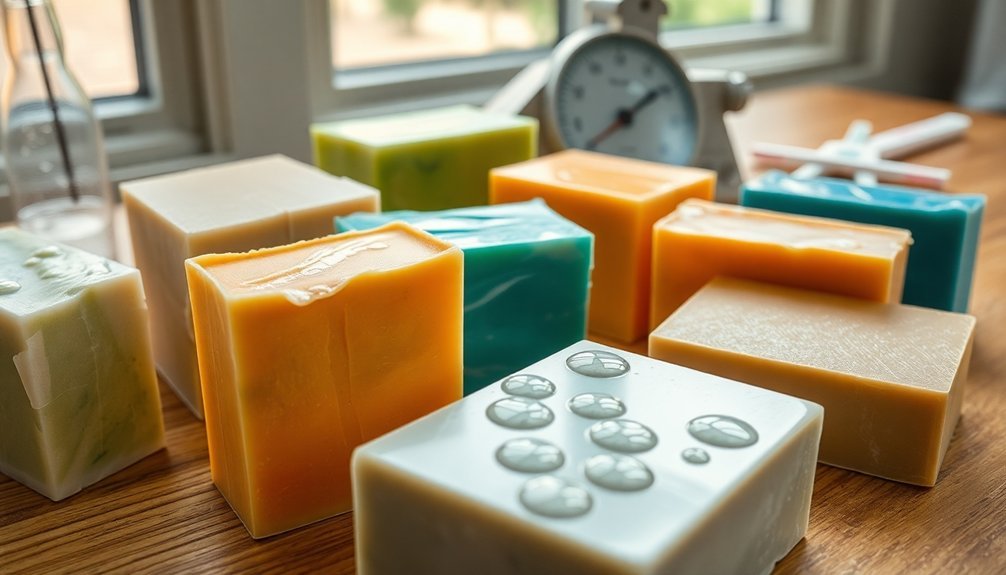
When crafting handmade soaps, understanding hardness measurement isn't just a technical detail—it's fundamental to producing a quality product that meets user expectations.
Soap hardness is measured through a calculated "hardness rating," which sums the percentages of lauric, myristic, palmitic, and stearic fatty acids in your formula. Quality soap typically falls within a hardness range of 29-54. This number reflects durability rather than physical firmness alone. Extended curing time significantly increases the physical hardness of soap bars regardless of their calculated hardness rating.
You'll notice that pH levels considerably impact hardness, with neutral pH providing ideal stability.
When testing your soap's hardness, remember that environmental factors like humidity and storage conditions will affect your measurements. Even your water type matters—hard water reacts with soap differently, forming scum that can alter both perceived and actual hardness.
Understanding these interactions helps you create soaps that maintain their integrity over time.
Physical Testing: Drop and Pressure Methods
You'll find drop tests essential for evaluating how your handmade soaps withstand real-world impacts from standard heights onto both soft and hard surfaces.
Compression testing techniques measure your soap's resistance to deformation when controlled pressure is applied, offering insights into structural integrity under stress.
These physical tests provide critical data about durability that helps you formulate soaps that maintain their hardness longer during everyday use. Always perform proper pH testing during production to ensure your soap is not only durable but also safe for skin contact.
Drop Test Methods
To properly evaluate a handmade soap's durability, various drop test methods provide valuable insights into how well your product will withstand everyday handling.
These tests typically involve dropping uniform soap pieces from heights ranging from 10 cm to 1 meter onto specified surfaces.
You'll want to standardize your testing by using consistent soap sizes and controlled environmental conditions, as temperature and humidity can greatly affect results.
Record the number of drops until failure occurs—this data allows for meaningful comparisons between different soap formulations.
For thorough assessment, conduct tests on both hard surfaces like marble (simulating bathroom counters) and softer surfaces like fabric (representing shower caddies).
Remember that soaps with higher pH levels tend to be softer and typically perform worse in drop tests than their harder counterparts. Conducting drop tests after different curing periods can help determine if your soap has fully cured, as properly cured soaps should show no pink coloration when tested with phenolphthalein drops.
Compression Testing Techniques
Unlike drop tests which simulate impact forces, compression testing provides essential insights into how your handmade soaps respond to sustained pressure over time.
These standardized techniques, often following ASTM methods like D937-92, measure a soap's resistance to deformation by applying controlled pressure to samples.
When testing your soaps, penetration measurements reveal valuable information about texture quality, identifying issues like trapped air or grainy consistency through force reading fluctuations. Experienced soap makers also perform a zap test to ensure no caustic substances remain before compression testing begins.
You'll find that fatty acid composition and water content greatly influence results, while temperature conditioning guarantees consistent evaluation across different storage scenarios.
Beyond quality control, compression testing helps you develop harder, longer-lasting formulations by comparing different recipes under identical conditions.
Though specialized equipment can be expensive, this methodology offers cost-effective benefits by identifying durability issues before your soaps reach customers.
Water Dissolution Rate Testing for Soap Bars
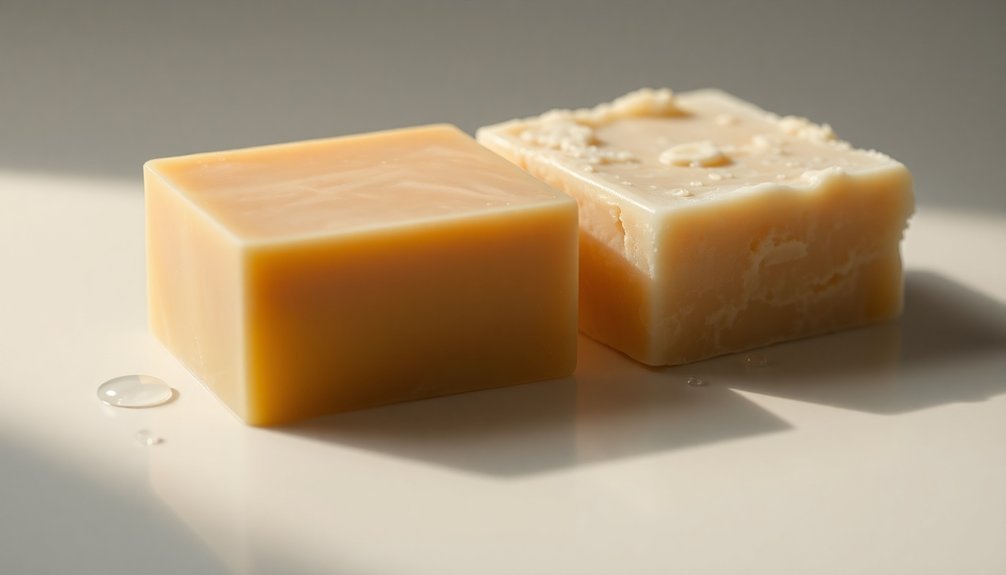
While many soap makers focus on scent and appearance, understanding the water dissolution rate of handmade soap bars is equally essential for product quality and consumer satisfaction. You'll want to test how quickly your soap dissolves when exposed to water, as this directly impacts your product's longevity and value. The hardness testing conducted with a sclerometer device can provide valuable insights into potential dissolution rates.
| Test Method | What It Measures |
|---|---|
| Weight Loss | Soap mass before and after water exposure |
| Depth Test | Surface degradation over time |
| Lather Test | Dissolution rate during actual use |
| Time-lapse | Visual documentation of breakdown |
| pH Changes | Chemical stability in water |
These standardized tests help you quantify dissolution rates objectively. Consider that higher fat content (TFM) typically results in slower dissolution, while excessive moisture content accelerates it. Environmental factors like temperature and humidity will also considerably impact how quickly your soap bars break down in water.
Using Penetrometers to Quantify Soap Firmness
Penetrometers provide soap makers with an objective method to measure the firmness of their handmade bars, transforming subjective impressions into quantifiable data.
This simple yet effective device works by dropping a weighted cone onto your soap's surface and measuring how deeply it penetrates.
The process delivers precise measurements that can help you:
Precise firmness data transforms soap making from intuitive art to measurable science, enabling formula optimization and consistent quality.
- Compare different formulations to determine which recipe creates longer-lasting bars
- Track how firmness changes during the curing process
- Establish quality control standards for consistent product development
- Quantify the effects of different oils and additives on final bar hardness
With proper temperature control and sample preparation, you'll get reliable results accurate to 0.1mm.
This data allows you to make informed adjustments to your recipes rather than relying on guesswork.
After testing, ensure your sample has a smooth surface without air bubbles to maintain the standard testing conditions needed for consistent measurements.
Moisture Content Analysis in Cured Soaps
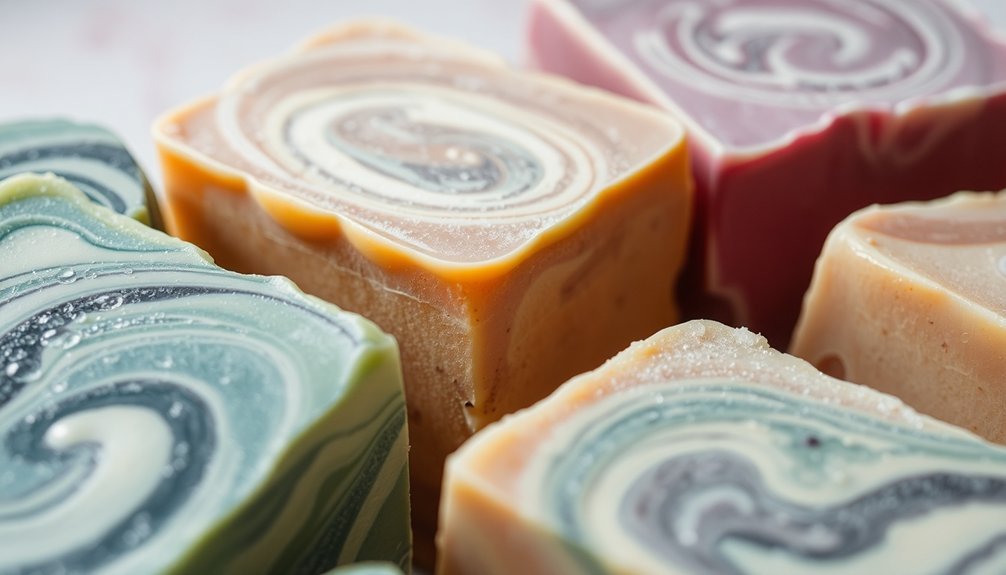
Understanding the moisture content in your cured soaps provides essential insight into their quality, longevity, and performance. You can measure this vital factor by weighing your soap over time until it reaches a constant weight, signaling complete curing.
For precise measurements, use a scale to weigh soap before and after drying, then calculate the moisture percentage. Some soapmakers employ specialized equipment like the Precisa Moisture Analyser for more accurate results, especially with liquid soaps.
Your soap's environment greatly impacts moisture equilibrium. Soaps cured in well-ventilated, cooler, and drier conditions harden faster than those in humid settings. Different processing methods affect moisture retention, with hot process soaps typically losing less water (around 6-9%) during curing than cold process varieties which lose approximately 15%.
Remember that recipes with lower water-to-lye ratios (around 1.7-1.8:1) typically cure in about four weeks, while high olive oil formulations like Castile require longer curing periods.
Fatty Acid Profile Testing and Hardness Correlation
The chemical composition of your soap's fatty acids directly determines its hardness, durability, and overall performance characteristics.
When testing soap hardness through fatty acid profiling, the balance between saturated and unsaturated fatty acids becomes vital.
SoapCalc and similar tools predict hardness by calculating the sum of saturated fatty acids in your formula.
You'll notice several key relationships:
- Higher saturated fat content (lauric, palmitic, stearic acids) = harder, more durable soap
- Carbon chain length matters – C16:0–C18:0 fatty acids contribute considerably to soap solidity
- Unsaturated fatty acids (like in olive oil) create softer bars but enhance conditioning
- Balancing fatty acid types is essential for creating soap that's both hard and skin-friendly
Understanding these relationships helps you formulate soaps with ideal hardness while maintaining desired properties.
The saponification value of different oils can guide you in predicting how each fat will contribute to your soap's final hardness.
Comparing Hardness Across Different Oil Formulations
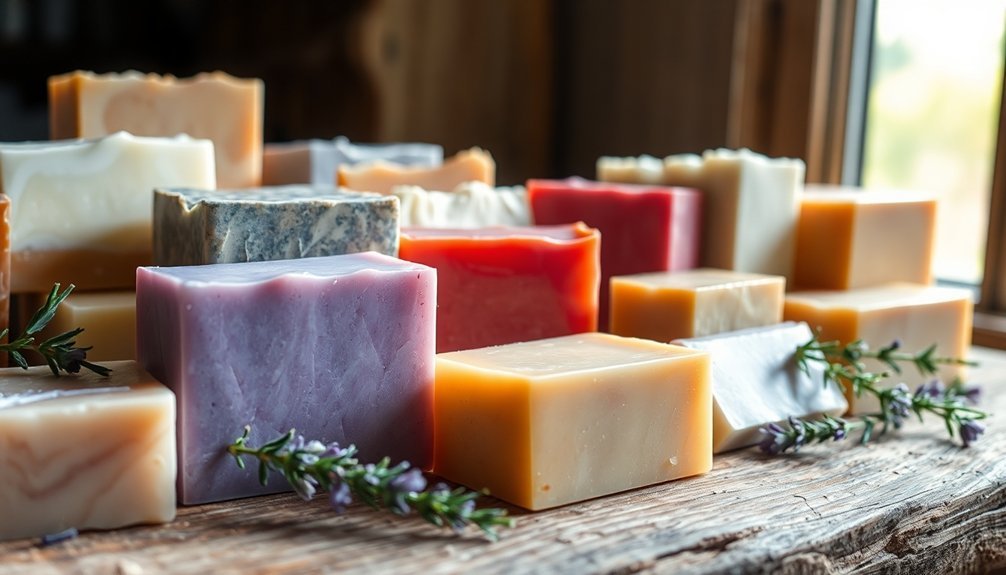
When testing soap hardness, you'll find dramatic differences between single-oil formulations, with coconut and tallow producing markedly harder bars than olive or castor oil alone.
A balanced formula combining hard oils (like palm or coconut) with conditioning oils creates the ideal blend of hardness and skin benefits. The addition of tallow, a traditional ingredient, contributes to creating long-lasting bars with excellent structural integrity.
You can further enhance your soap's hardness by reducing water content during formulation, which accelerates the curing process and results in firmer finished bars.
Single Oil Hardness Test
Five distinct oils can dramatically alter your soap's hardness when used as single-oil formulations.
When testing soap hardness, you'll find remarkable differences in texture, longevity, and performance based solely on oil selection.
The hardness hierarchy from these tests shows:
- Coconut and Babassu Oils – Create exceptionally hard bars due to high saturated fatty acid content, with excellent lathering properties.
- Rice Bran Oil – Produces surprisingly hard bars despite slower setup times.
- Castor Oil – Delivers harder-than-expected results but often with sticky texture.
- Hempseed Oil – Yields softer bars that tend to develop rancidity quickly.
While single-oil soaps provide valuable insights into hardness properties, they often lack balance in other important qualities like moisturizing and cleansing, which is why most soapmakers prefer blended formulations. Olive oil soaps require 48 hours to unmold, making them a moderate option for hardness in single-oil formulations.
Balanced Formula Benefits
Combining oils in strategic ratios creates considerably more balanced soaps than single-oil formulations ever could.
When you blend tallow's hardness-enhancing properties with olive oil's conditioning benefits, you're crafting a bar that maintains structural integrity while nourishing skin.
The secret lies in understanding each oil's fatty acid profile. Coconut oil contributes hardness and bubbles but can be drying when overused.
Shea butter adds moisture while maintaining firmness. This ingredient is especially beneficial as it supports skin elasticity and provides long-lasting moisture while contributing to the soap's structural integrity. Even castor oil, though not directly hardness-enhancing, stabilizes texture and improves feel.
You'll find the most durable and skin-friendly soaps contain thoughtfully proportioned combinations—typically featuring hard oils (tallow, palm) balanced with conditioning ones (olive, shea).
This approach guarantees your bars remain firm throughout use while delivering balanced cleansing properties without excessive dryness.
Water Content Effects
Water content dramatically influences both the hardness and longevity of your handmade soaps, regardless of which oils you've selected for your formula.
Finding the ideal water-to-lye ratio is essential for creating bars that last longer on your shower shelf.
When adjusting your water content, remember these key factors:
- Water discounting (using less water) creates harder bars that cure faster but may accelerate trace during mixing.
- High water content produces softer soaps with longer curing times and potential glycerin rivers.
- Different oils require different ratios – coconut and palm oils need more water due to heating tendencies, while olive oil soaps benefit from less. Water hardness can significantly impact the performance of your soap, as divalent cations interact with sodium and potassium salts in your soap formula.
- Water-to-lye ratios typically range from 1:1 to 3:1, with lower ratios producing harder, longer-lasting bars.
Accelerated Aging Tests for Longevity Prediction
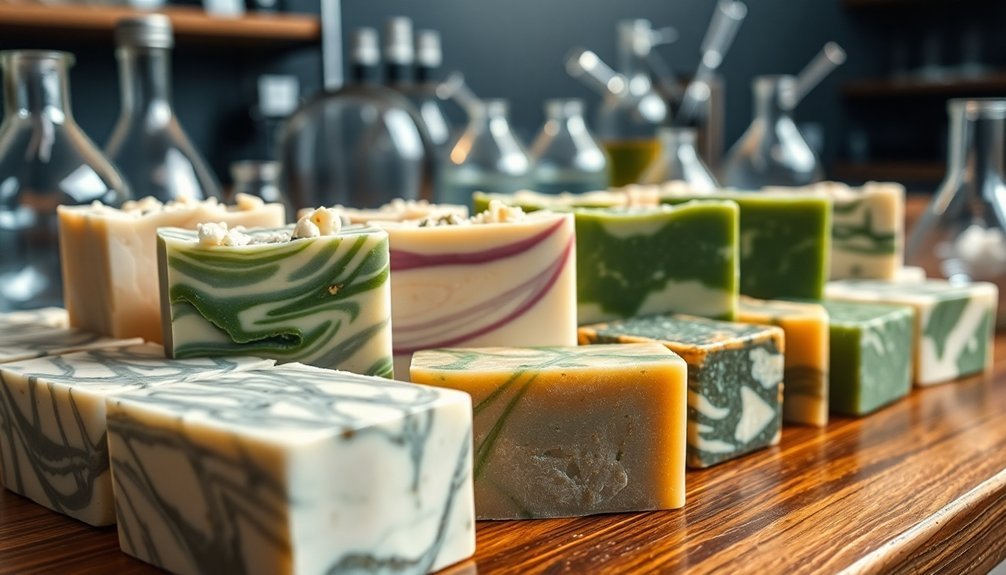
As handcrafted soap artisans seek to understand how their products will perform over time, accelerated aging tests offer an invaluable scientific approach to predicting longevity.
By subjecting soaps to elevated temperatures (while maintaining 45-55% relative humidity), you can simulate months or years of aging in just weeks.
These tests follow the Arrhenius equation, which relates temperature increases to reaction rates. You'll gain critical insights into how your soap formulations hold up against time's effects without waiting for real-time results.
For soapmakers looking to optimize recipes or validate shelf life claims, these tests provide competitive advantages through faster market entry.
While accelerated testing shouldn't replace real-time observation entirely, it gives you actionable data about hardness retention, fragrance stability, and material degradation much sooner than conventional methods. A common baseline is that 6.5 weeks at 55°C simulates approximately one year of shelf life under normal storage conditions.
Humidity Resistance Testing for Soap Durability
When exposed to varying humidity levels, handmade soaps face considerable durability challenges that can compromise their quality and shelf life. Manufacturers employ humidity chambers to simulate environmental conditions and measure soap performance under controlled moisture exposure. Accurate saponification values of oils used in formulation directly impact a soap's resistance to humidity degradation.
To guarantee your handmade soaps maintain their hardness despite humidity challenges:
- Monitor Relative Humidity (RH) – High RH accelerates soap softening and causes surface "sweating"
- Implement proper storage solutions – Airtight containers with silica gel sachets absorb excess moisture
- Choose humidity-resistant ingredients – Long-chain fatty acids and certain oils enhance moisture resistance
- Store in cool, dry environments – Prevent humidity absorption by using proper ventilation and drainage
These measures appreciably extend your soap's durability while maintaining its quality, appearance, and effectiveness against environmental moisture challenges.
Ph Testing and Its Relationship to Soap Structure
The precise pH balance of your handmade soap directly influences its molecular structure, functional properties, and compatibility with human skin. Typically ranging between 7-10, a well-balanced soap's pH affects not only how your skin feels after use but also the soap's overall durability.
During saponification, your soap evolves from highly alkaline (pH 14) to a milder 7-10 range as it cures. Soaps with pH closer to skin's natural level (around 7-8) are gentler while maintaining structural integrity. Regular testing with pH strips or meters throughout the curing process helps guarantee your soap reaches ideal stability. Understanding surfactant behavior in different water types can further inform how your soap will perform in various household conditions.
The correlation between pH and hardness is significant—properly balanced formulations resist moisture absorption, maintaining firmness longer. This balance also prevents rancidity and extends shelf life, making pH testing essential for crafting long-lasting, skin-friendly bars.
Evaluating Cure Time Effects on Final Bar Hardness
Proper curing transforms your handmade soap from a soft, moisture-laden bar into a resilient, long-lasting product that performs at its best.
During the 4-6 week curing period, excess water evaporates while the soap undergoes important chemical changes that enhance its properties.
You'll notice several measurable improvements as your soap cures:
- Weight reduction – Tracking weight loss helps monitor moisture evaporation, with properly cured soap typically losing 10-15% of its initial weight.
- Increased longevity – A well-cured bar can last twice as long as an uncured one when used in your shower. Soaps with higher percentages of hard oils like palm and coconut will generally remain firmer throughout their use life.
- Enhanced lather quality – Lather becomes richer and more stable as the crystalline structure develops.
- Improved skin feel – The pH gradually decreases, making the soap gentler on your skin.
Frequently Asked Questions
Does Using Milk Instead of Water Affect Soap Hardness?
Yes, milk typically makes your soap softer than water due to its lactic acid and higher moisture content. You'll notice longer hardening times and may need to adjust recipes or add hardening agents accordingly.
Can Essential Oils or Fragrances Reduce Soap Longevity?
Yes, essential oils can reduce your soap's longevity, especially citrus-based scents that oxidize faster. They lack preservatives and may degrade over time, particularly when you've added them in higher concentrations to your recipe.
How Do Colorants Impact Soap Hardness Over Time?
Colorants typically don't impact your soap's hardness over time. While some natural colorants may fade, they won't affect the structural integrity. It's the oils, fats, and curing process that determine long-term hardness.
Does Molding Technique Influence Final Soap Hardness?
Yes, your molding technique directly impacts soap hardness. Molds that allow more airflow (like wooden ones) promote faster gel phase and complete saponification. You'll get harder bars when you prioritize ventilation during the curing process.
Can Temperature During Saponification Affect Lasting Hardness?
Temperature during saponification won't greatly affect your soap's lasting hardness. While it may influence initial firmness through gel phase, long-term hardness depends more on your ingredient choices and proper curing time.
In Summary
You'll find that measuring your soap's hardness isn't just about personal preference—it's science. By using physical tests, analyzing water dissolution rates, measuring penetration resistance, and monitoring moisture content, you can objectively evaluate your bars. Don't forget to take into account pH levels and conduct accelerated aging tests. With these methods, you'll understand why some handmade soaps truly do remain harder longer than others.

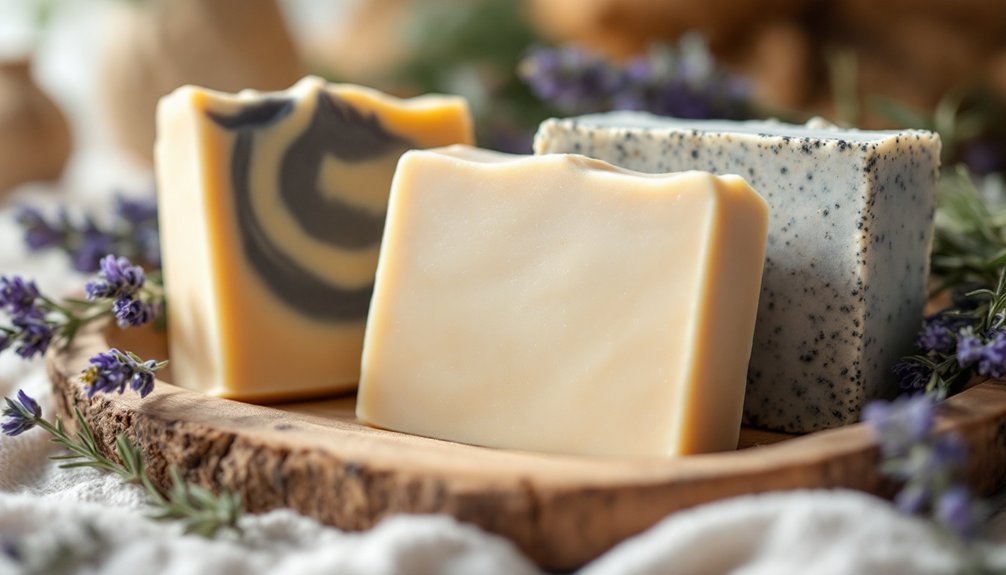



Leave a Reply